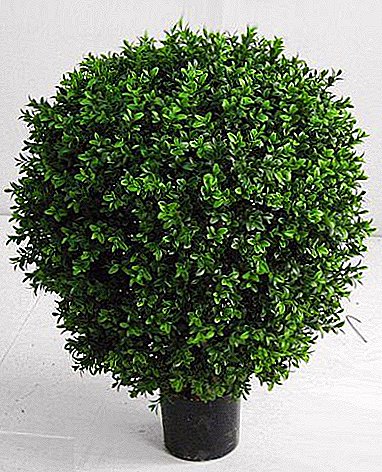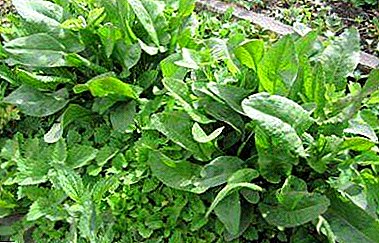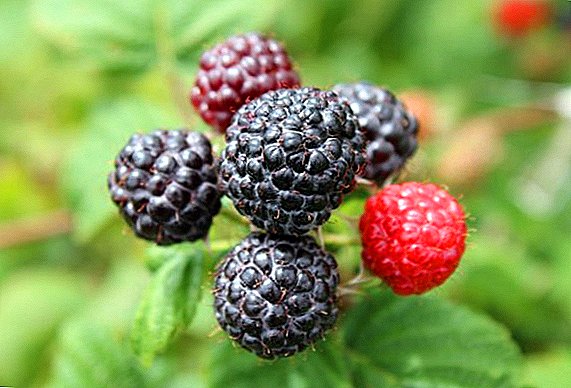
Buxus has gained its popularity among gardeners due to its appearance: brilliant foliage and dense crown.
Plant can take a fancy look thanks to the artistic trimming of boxwood, which it tolerates well.
Boxwood grows slowly, but lives long - up to 500 years. Slow growth allows the created figure to persist for a long time, without requiring frequent adjustments.
Often enough plant used as a “living fence”, as with a tight fit, boxwood creates a completely impenetrable green wall.
Such an element of outdoor decor able to bring a special personality to landscape design and emphasize the site owner’s relationship with nature.
Caring for boxwood at home, how to plant boxwood, reproduction, care, photos - all this and not only you will find in this article.
Description
 The "boxwood" family includes about 30 species, and the scientific name of the species most used in gardening is Buxus sempervirens, or evergreen boxwood (more details about the types of boxwood can be found here, and more details about Colchis boxwood listed in the Red Book can be found in this article).
The "boxwood" family includes about 30 species, and the scientific name of the species most used in gardening is Buxus sempervirens, or evergreen boxwood (more details about the types of boxwood can be found here, and more details about Colchis boxwood listed in the Red Book can be found in this article).
The area of its natural distribution - Mediterranean and Southeast Asian countries, some areas of Africa and Central America.
Boxwood in the wild can be found in the Caucasus, although quite rarely.
The box grows in the form of an evergreen shrub or tree, from 2 to 13 m high. Some species of the plant can reach 15 m. The leaves are round or elliptical in shape, oppositely arranged, 2-3 cm long. The upper side of the leaves is dark green, the lower side is lighter.
In the decorative types of leaf color may vary:
- golden;
- motley
- bordered
It blooms with small flowers of a greenish shade, collected in axillary inflorescences. They emit fragrance and are same-sex, that is, each flower has either only pistils, or only stamens.
The fruit is a box with three nests, from which, after ripening, brilliant seeds of black color fall out.
IMPORTANT! The plant is poisonous, especially high content of toxic substances in the leaves.
Your attention shrub box on the photo:




Shrub boxwood: planting and care at home
Buksus does not require a special light mode, feeling yourself the same way good both in the sun and in a shaded place. For breeding boxwood at home, room temperature is quite suitable, and a window on the south side is better suited for a pot.
In winter, when slowing down biorhythms, temperature reduction to 15ºC is acceptable. For breeding boxwood and care for it on the street, only a few frost-resistant varieties are suitable, and it is recommended to cover those in the winter period.
Watering
In summer, the box should be watered fairly plentifully as the soil dries. In the autumn, with a decrease in air temperature, watering is reduced to moderate.
ATTENTION! Excessive waterlogging leads to stagnant moisture in the root system and putrefactive processes.
Humidity
 Moderately moist air is most favorable for boxwood.
Moderately moist air is most favorable for boxwood.
If the plant lives in a flower pot, then its leaves must be sprayed from time to time.
These measures will prevent drying and twisting of the leaves, as well as become a preventive against the appearance of some pests.
Transplant and soil
Due to slow growth, transplantation is rarely transplanted once in several years. It is better to replant in the spring, in March or April. For boxwood transplantation, a pot of slightly larger volume is used than the previous one.
As a rule, the plant tolerates transplantation easily, if you remember to make at the bottom of the tank drainage layer. Otherwise, the moisture will stagnate at the roots and the plant will hurt.
Boxwood prefers a structured, nourishing soil. The necessary composition can be purchased at a specialty store or you can make one yourself by mixing leafy, soddy soil with coarse sand.
Recommended composition:
- sod land - 4 parts;
- leafy ground - 2 parts;
- coarse sand - 1 part.
IMPORTANT! If the plant has been purchased, it is better to transplant it, since the transport soil is not very good and dries quickly.But this should be done carefully, trying not to damage the roots. A day before transplanting, saplings of boxwood should be watered abundantly, this will allow you to maximally relax the earthen room.
Breeding
 How to propagate boxwood? Breeding boxwood at home both cuttings and seeds occurs as follows.
How to propagate boxwood? Breeding boxwood at home both cuttings and seeds occurs as follows.
Cuttings are cut only from fairly developed plants, in April or May.
The entire growth of last year is taken with a small capture of the last year’s one. Usually such The cutting has a length of 15-20 cm.
The shoot is placed in the ground with the addition of a root formation stimulator, for the first time the plant should be covered, creating something like a greenhouse.
When breeding boxwood cuttings the first roots appear in a month and by autumn the plant takes root completely.
When growing boxwood from seeds that must be stratified before sowing for 2 months, thereby increasing germination. After that, you can land in open ground or in a pot, but in both cases be sure to cover.
The soil for planting boxwood should be nutritious. When seedlings appear, plants can be transplanted into separate pots. Minus reproduction boxwood seeds in that in this case the plant will grow and develop more slowly.
For more information about cutting a boxwood, see the video:
Flowering and crown formation
You can trim room boxwood throughout the year, as needed. For this purpose it is necessary to use sharp garden shears. Cut branches become later still thicker and lush.
The boxwood pleases with its flowers not every year, but if it does, then in spring. The flowers look inconspicuous: small, greenish-yellow. But when flowering the room is filled with a special aroma.
Watch the following video about trimming boxwood:
Diseases and pests
On the indoor box, such pests can parasitize:
- shield;
- aphid;
- spider mite;
- gallicia boxwood
 For the extermination of pests insecticides are used.
For the extermination of pests insecticides are used.
It should be remembered that most of the pests infect weakened plants; therefore, adherence to common standards for growing boxwood is a kind of prevention against infection.
One of the common ailments affecting boxwood is psilla disease Its signs - a significant slowdown in growth, deformation of the leaves and the appearance of sticky wax formations.
The affected parts of the plant should be removed and destroyed. With too much watering or insufficient drainage, brown spots appear on the leaves.
Why yellow boxwood?
Insufficient moisture or too dry climate leads to twisting, drying out and yellowing of the leaves.
Growing boxwood at home not only adds to the interior of the room, but also has a positive effect on health. Thanks to the volatile substances released by the plant (phytoncides), harmful bacteria are neutralized in the room air. In addition, during flowering boxwood emits a pleasant smell.
From our article you have learned how to properly care for buksus, how fast the box grows, how it multiplies at home, how to grow box and how to plant a plant.












